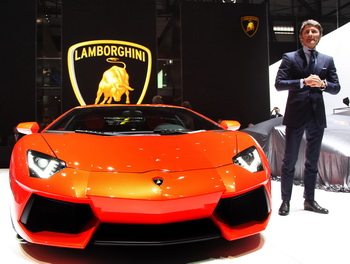 |
|
Lamborghini CEO
Stephan Winkelmann introduces the Aventador
LP700-4 at the Geneva Motor Show earlier
this month: the new sports car significantly
pushes forward the Italian brand's use of
lightweight materials. |
|
|
|
Lamborghini’s
participation in the 2011 edition of the JEC Composite
Show in Paris - one of the world’s most important
exhibitions of composite materials - is intended to
emphasise its abilities in this highly specialised
sector, not only in applying these materials in mass
production (as shown by the new Aventador LP 700-4), but
also in the investigation and development of new
manufacturing technologies and the resulting product
spin-offs.
The use of composite materials reinforced with carbon
fiber is becoming increasingly widespread in the
automotive sector, as revealed by a study by Lucintel
that foresees a growth of 65 percent over the next 5
years. Many manufacturers are working on developing and
applying these technologies so they can build lighter
vehicles that make an important contribution to reducing
fuel consumption and air pollution, through improvements
that include increasing the strength of the vehicle’s
structures.
Automobili Lamborghini’s extensive experience with using
composite materials reinforced with carbon fiber in the
super sports car sector is demonstrated by the Sesto
Elemento concept car, where these materials have
resulted in maximum stiffness with minimum weight.
During the presentation of the vehicle at the
exhibition, Luciano De Oto, the Chief of the Lamborghini
Advanced Composite Research Center (ACRC), noted that
the complete vehicle weighs only 999 Kg, as compared
with the 1410 Kg of a Gallardo.
The widespread use of CFRP (various types of which were
used to build the wheel rims, frame, bodywork with roof,
seats, exhaust and suspension elements of the Sesto
Elemento) has enabled structures of extreme technical
sophistication and quality to be created, with
consequent improvement of the power-to-weight ratio for
greater driving pleasure, lower fuel consumption and
reduced CO2 emissions.
At its Advanced Composite Research Center (ACRC, a
section of the Automobili Lamborghini Research &
Development department directed by Maurizio Reggiani),
the Sant’Agata Bolognese-based company is working on
what technicians describe as “the new frontier” in
materials reinforced with carbon fiber. The company
already offers a host of applications for CFRPs, with
particular focus on components that can be built without
the need of an autoclave.
A prime example is forged composite, which adds new
prerogatives to the more traditional processes in the
autoclave. During his presentation at the JEC session
devoted to the automotive sector, Mr. De Oto explained
that the most significant development in this regard is
a “hybrid” combination employing long, unidirectional
carbon fiber. What’s more, ACRC research and development
activities aim at obtaining from forged composite,
through its pairing with finishing materials during the
molding process, components that meet Class A appearance
specifications.
Because they are easy to manufacture and cost relatively
little, these new types of finished elements are certain
to extend applications of CFRP into other sectors such
as the marine, furnishings, sporting equipment and
leisure vehicles segments. As a matter of fact, ACRC has
already cooperated with third parties and supplied
composite finished elements to companies belonging to a
broad gamut of sectors.
|
|
|